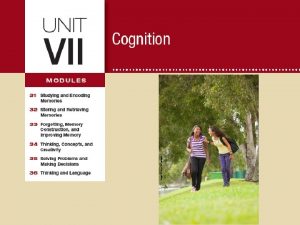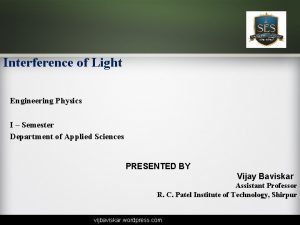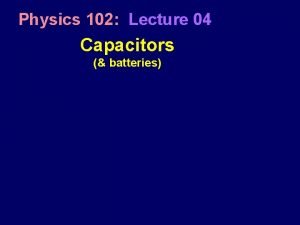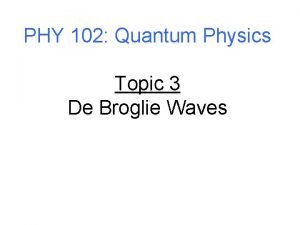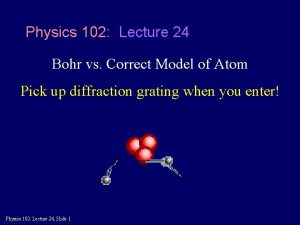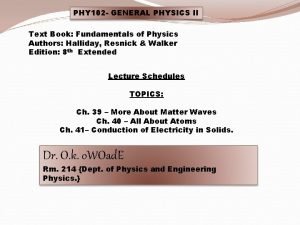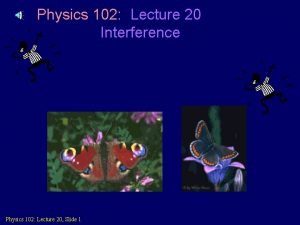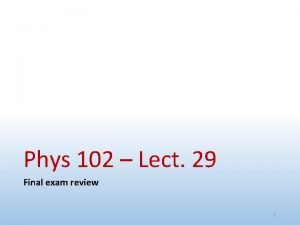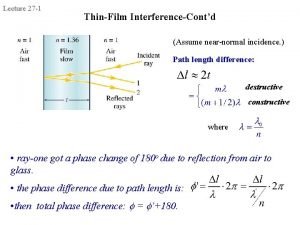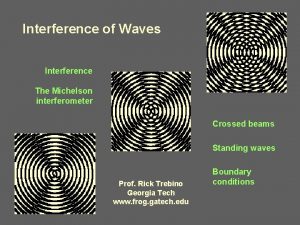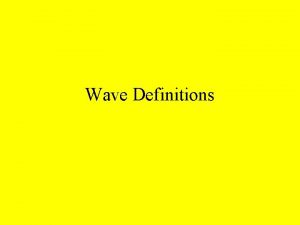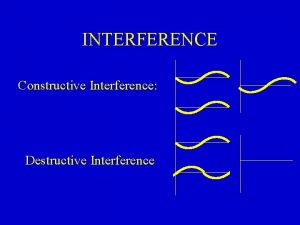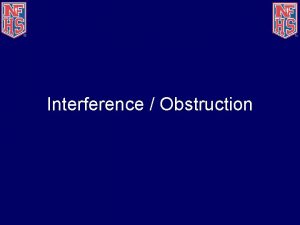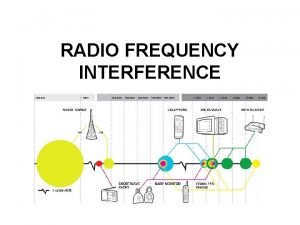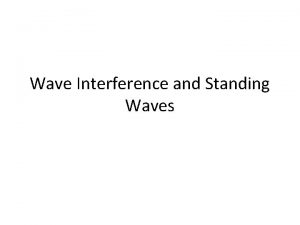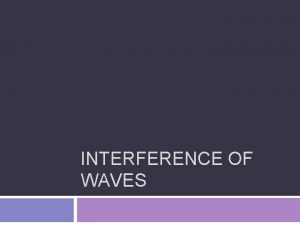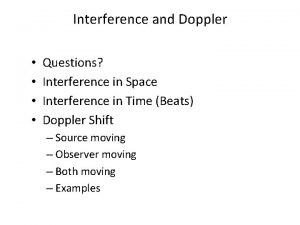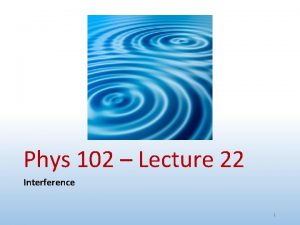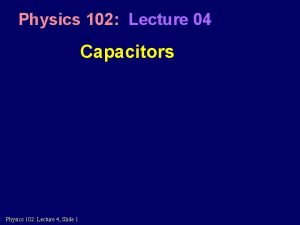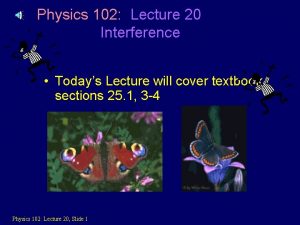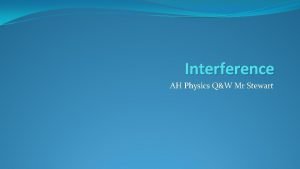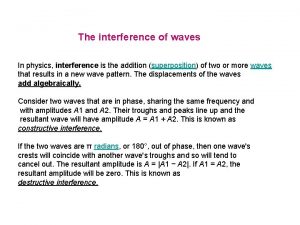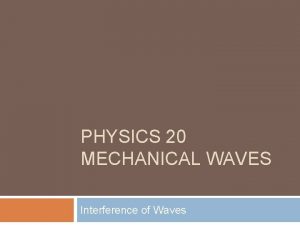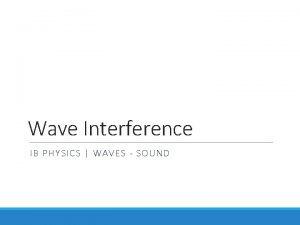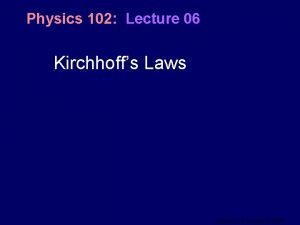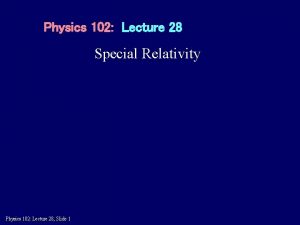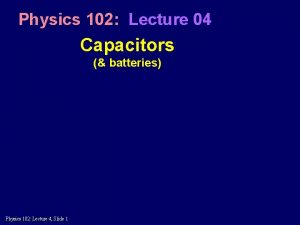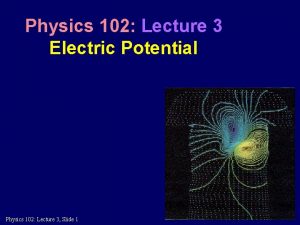Physics 102 Lecture 20 Interference Physics 102 Lecture





















- Slides: 21

Physics 102: Lecture 20 Interference Physics 102: Lecture 20, Slide 1

Phys 102 recent lectures Light as a wave • Lecture 14 – EM waves • Lecture 15 – Polarization • Lecture 20 & 21 – Interference & diffraction Light as a ray • • Lecture 16 – Reflection Lecture 17 – Spherical mirrors & refraction Lecture 18 – Refraction & lenses Lecture 19 – Lenses & your eye Physics 102: Lecture 20, Slide 2

Superposition Constructive Interference +1 -1 t + +1 -1 In Phase t +2 t -2 Physics 102: Lecture 20, Slide 3

Superposition Destructive Interference +1 -1 t + +1 -1 Out of Phase t +2 t -2 Physics 102: Lecture 20, Slide 4 180 degrees

ACT: Superposition + Different f 1) Constructive Physics 102: Lecture 20, Slide 5 2) Destructive 3) Neither

Interference Requirements • Need two (or more) waves • Must have same frequency • Must be coherent (i. e. waves must have definite phase relation) Physics 102: Lecture 20, Slide 6

Demo: Interference for Sound … For example, a pair of speakers, driven in phase, producing a tone of a single f and l: hmmm… I’m just far enough away that l 2 l 1=l/2, and I hear no sound at all! l 1 l 2 But this won’t work for light--can’t get coherent sources Physics 102: Lecture 20, Slide 7

Interference for Light … • Can’t produce coherent light from separate sources. (f 1014 Hz) • Need two waves from single source taking two different paths – Two slits Today’s lecture – Reflection (thin films) – Diffraction* Next lecture Physics 102: Lecture 20, Slide 8

Young’s double slit/rays Monochromatic light travels through 2 slits onto a screen What pattern emerges on the screen? Shadow Bright spots This is not what is actually seen! Physics 102: Lecture 20, Slide 9

Young’s double slit/Huygens Recall Huygens’ principle: Every point on a wave front acts as a source of tiny wavelets that move forward. Bright and dark spots on screen! • Constructive = bright Destructive = dark • Wave crests in phase = constructive interference Physics 102: Lecture 20, Slide 10

Young’s double slit: Key idea Consider two rays traveling at an angle q: • θ Bottom ray travels a little further (2 l in this case) • Key for interference is this small extra distance. Physics 102: Lecture 20, Slide 11

Young’s double slit: Quantitative Consider two rays traveling at an angle q Assume screen is very far away (L>>d): ≈ ≈ ≈ θ θ m = +2 Path length difference = dsin(q) L Constructive: dsin(q) = ml Destructive: dsin(q) = (m+1/2)l Physics 102: Lecture 20, Slide 12 where m = 0, 1, 2 Need l < d

Young’s double slit: Quantitative Assume screen is very far away (L>>d), angles q are small: m = +2 y θ θ m = +1 m=0 dsin(q) L m = -1 sin(q) tan(q) = y/L Constructive: dsin(q) = ml Destructive: dsin(q) = (m+1/2)l m = 0, 1, 2 Physics 102: Lecture 20, Slide 13 y ≈ ml. L/d y ≈ (m+1/2)l. L/d m = -2

ACT: Preflight 20. 3 When this Young’s double slit experiment is placed under water, the separation y between minima and maxima: m = +2 y θ θ m = +1 m=0 dsin(q) L m = -1 m = -2 1) increases Physics 102: Lecture 20, Slide 16 2) same 3) decreases

Preflight 20. 2 In the Young double slit experiment, is it possible to see interference maxima when the distance between slits is smaller than the wavelength of light? 1) Yes Physics 102: Lecture 20, Slide 17 2) No

Thin Film Interference Light is incident normal to a thin film Note: angles exaggerated for clarity 1 t 2 n 0=1. 0 (air) n 1 (thin film) n 2 Get two waves by reflection off two different interfaces: interference! Ray 2 travels approximately 2 t further than ray 1. Physics 102: Lecture 20, Slide 18

Reflection & Phase Shifts Upon reflection from a boundary between two transparent materials, the phase of the reflected light may change. Reflected Incident Reflected n 1 n 2 Refracted • If n 1 > n 2 – no phase change upon reflection Physics 102: Lecture 20, Slide 19 Incident • If n 1 < n 2 – 180º phase change upon reflection (shift by l/2)

Thin Film Summary Determine d, number of extra wavelengths for each ray. 1 2 n = 1. 0 (air) n 1 (thin film) t n 2 This is important! Reflection Distance Ray 1: d 1 = 0 or ½ + 0 Ray 2: d 2 = 0 or ½ + 2 t/ lfilm If |d 2 – d 1| = 0, 1, 2, 3 …. If |d 2 – d 1| = ½ , 1 ½, 2 ½ …. Physics 102: Lecture 20, Slide 20 Note: this is wavelength in film! (lfilm= lo/n 1) (m) constructive (m + ½) destructive

ACT: Thin Film Practice Blue light (l 0 = 500 nm) incident on a glass (n 1 = 1. 5) cover slip (t = 167 nm) floating on top of water (n 2 = 1. 3). 1 t 2 n = 1. 0 (air) n 1 (thin film) n 2 What is d 1, the total phase shift for ray 1 A) d 1 = 0 Physics 102: Lecture 20, Slide 21 B) d 1 = ½ C) d 1 = 1

Thin Film Practice Blue light (l 0 = 500 nm) incident on a glass (n 1 = 1. 5) cover slip (t = 167 nm) floating on top of water (n 2 = 1. 3). 1 t 2 n = 1. 0 (air) n 1 (thin film) n 2 Is the interference constructive or destructive or neither? d 1 = d 2 = Physics 102: Lecture 20, Slide 22 Phase shift = |d 2 – d 1| =

ACT: Thin Film Practice II Blue light (l 0 = 500 nm) incident on a glass (n 1 = 1. 5) cover slip (t = 167 nm) floating on top of plastic (n 2 = 1. 8). 1 2 n = 1. 0 (air) n 1 (thin film) t n 2 Is the interference : 1) constructive 2) destructive d 1 = d 2 = Physics 102: Lecture 20, Slide 23 Phase shift = |d 2 – d 1| = 3) neither?
 Example of retroactive interference
Example of retroactive interference Retrospective interference
Retrospective interference Interference of light engineering physics
Interference of light engineering physics Physics 102
Physics 102 Physics 102
Physics 102 Electric potential lecture
Electric potential lecture Physics 102
Physics 102 Physics 102 uiuc
Physics 102 uiuc Physics 102
Physics 102 Physics 102
Physics 102 Physics 102
Physics 102 Physics 102 final exam
Physics 102 final exam 01:640:244 lecture notes - lecture 15: plat, idah, farad
01:640:244 lecture notes - lecture 15: plat, idah, farad Phy101 lecture 1
Phy101 lecture 1 Physics 101 lecture notes pdf
Physics 101 lecture notes pdf Physics 101 lecture notes pdf
Physics 101 lecture notes pdf What is wave motion
What is wave motion Physics 111 lecture notes
Physics 111 lecture notes Atmospheric physics lecture notes
Atmospheric physics lecture notes Interference in thin film
Interference in thin film Constructive vs destructive interference
Constructive vs destructive interference Elastic medium meaning
Elastic medium meaning

